What prompted me to write this short essay was there are circulating lies concocted by Liar Christians such as Dr Amari Rafat that KAHBA/MECCAH didnt exist before 400AD! This liar even added more lies to his lies that there is no single scholars who recorded that KAHBA existed before 400AD!
This lie was maliciously espoused by some low level internet troll who ignorantly added that Prophet Abraham therefore didnt built the Kahba! How true is that? Well this is simply UNTRUE! Scholars have recorded the existence of Kahba / Mecca even before the Christianity came into existence.
1. Diodorus Siculus was a Greek historian,
https://archive.org/stream/religiousceremon00good#page/124/mode/2up
Diodorus Siculus was a Greek historian,
who wrote works of history in the 1st Century BC. He is known for the
monumental universal history Bibliotheca historica. Diodorus is the
first known Historian long before the coming of Islam that makes mention
of Mecca.
Reverend Charles Augustus Goodrich a
Christian, was an American author and Congregational minister comments
on Kaaba and Mecca, although, he is not fond of the Prophet Muhammed
(pbuh), but he is sincere in admitting that Ka’bah existed at the time
of Patriarchs. He writes:
“Among the variety of fabulous traditions which have been propagated by the followers of Mahomet, concerning the origin of this building, we find it asserted, that its existence is coeval with our parents, and that it was built by Adam, after his expulsion from paradise, from a representation of the celestial temple, which the almighty let down from heaven in curtains of light and placed in Mecca, perpendicular under the original. To this the patriarch was commanded to turn his face when he prayed, and to compass it by way of devotion, as the angels did the heavenly one. After the destruction of this temple by the deluge, it was rebuilt by Abraham and his son Ishmael on the same spot, and after the same model, according to directions, which they received by revelation; and since that time, it has continued to be the object of veneration to Ishmael’s descendants. Whatever discredit we may give to these, and other ravings of the Moslem imposter concerning the Caaba its high antiquity cannot be disputed; and the most probable account is, that it was built and used for religious purposes by some of the early patriarchs; and after the introduction of idols, it came to be appropriated to the reception of the pagan divinities. Diodorus Siculus, in his description of the cost of the Red Sea, mentions this temple as being, in his time, held in great veneration by all Arabians; and Pocoke informs us, that the linen or silken veil, with which it is covered, was first offered by a pious King of the Hamyarites, seven hundred years before the time of Mahomet.”
Mecca , which is pronounced in Arabic As Makkah
is the birth place of islamic Prophet Muhammed and also the birth place
of Islam preached and propagated by Muhammed and his Followers.
Historical Mention of Mecca come way before islam and Muhammad for example Greek Historian Diodorus Siculus (Διόδωρος Σικελιώτης) mention mecca and the Kaaba as
””And a temple has been set up there, which is very holy and exceedingly revered by all Arabians” ,this mention comes around 30 -50 BC (Before Christ) Almost 2000 years ago Greek historians mention Mecca or say Makkah as it is orginally pronounced .
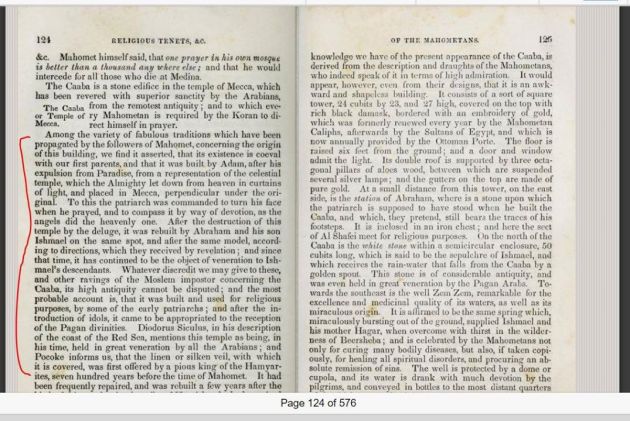
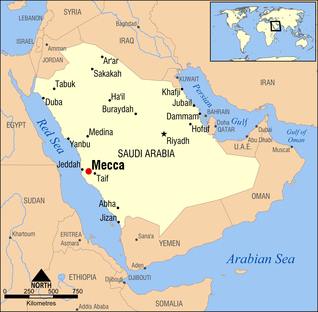
============================================================================
2. Ptolemy’s
Ancient Greek Geographer Ptolemy
mention and Locate Mecca (Makkah) in his World map in 90 AD , He call
Mecca as “Macoraba” in Arabic مكة .maco – raba means House of Rab
(Lord) . Islamic scripture Quran Identify Mecca as Makkah and mention
the Kaaba as Kaaba , House of Allah ( Rab ) and Bakkah ( as in arabic
”m” and ”b” are interchangeably used )
(Ptolemy’s World Map Mentioning Mecca in Hejaz )
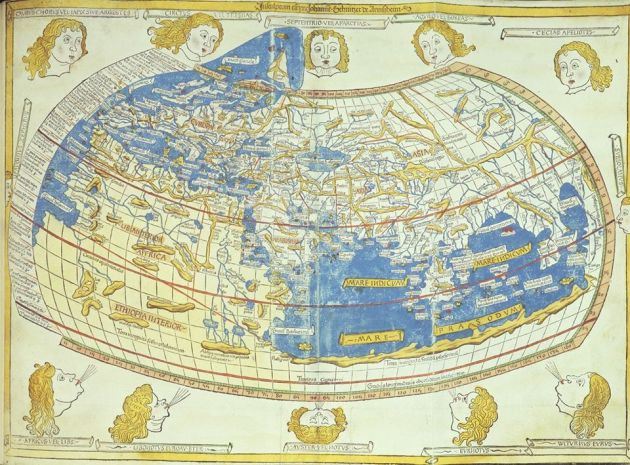
MACORABA
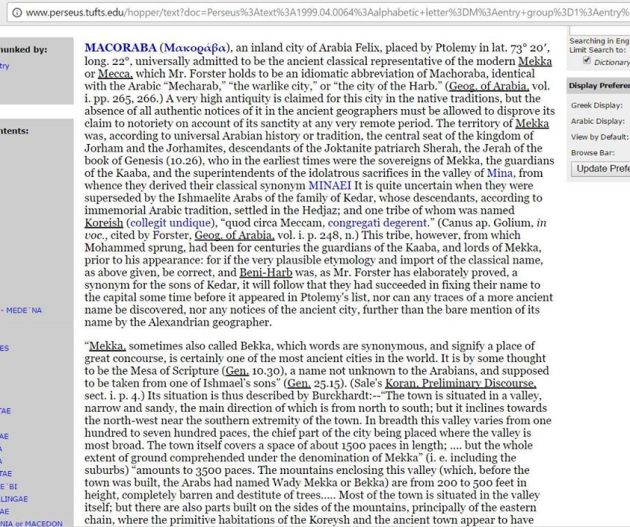
ONLINE SOURCE :
MACORABA (Μακοράβα), an inland city of Arabia Felix, placed by Ptolemy in lat. 73° 20′, long. 22°, universally admitted to be the ancient classical representative of the modern Mekka or Mecca, which Mr. Forster holds to be an idiomatic abbreviation of Machoraba, identical with the Arabic “Mecharab,” “the warlike city,” or “the city of the Harb.” (Geog. of Arabia, vol. i. pp. 265, 266.) A very high antiquity is claimed for this city in the native traditions, but the absence of all authentic notices of it in the ancient geographers must be allowed to disprove its claim to notoriety on account of its sanctity at any very remote period. The territory of Mekka was, according to universal Arabian history or tradition, the central seat of the kingdom of Jorham and the Jorhamites, descendants of the Joktanite patriarch Sherah, the Jerah of the book of Genesis (10.26), who in the earliest times were the sovereigns of Mekka, the guardians of the Kaaba, and the superintendents of the idolatrous sacrifices in the valley of Mina, from whence they derived their classical synonym MINAEI It is quite uncertain when they were superseded by the Ishmaelite Arabs of the family of Kedar, whose descendants, according to immemorial Arabic tradition, settled in the Hedjaz; and one tribe of whom was named Koreish (collegitundique), “quod circa Meccam, congregatidegerent.” (Canus ap. Golium, in voc., cited by Forster, Geog. of Arabia, vol. i. p. 248, n.) This tribe, however, from which Mohammed sprung, had been for centuries the guardians of the Kaaba, and lords of Mekka, prior to his appearance: for if the very plausible etymology and import of the classical name, as above given, be correct, and Beni-Harb was, as Mr. Forster has elaborately proved, a synonym for the sons of Kedar, it will follow that they had succeeded in fixing their name to the capital some time before it appeared in Ptolemy’s list, nor can any traces of a more ancient name be discovered, nor any notices of the ancient city, further than the bare mention of its name by the Alexandrian geographer.“Mekka, sometimes also called Bekka, which words are synonymous, and signify a place of great concourse, is certainly one of the most ancient cities in the world. It is by some thought to be the Mesa of Scripture (Gen. 10.30), a name not unknown to the Arabians, and supposed to be taken from one of Ishmael’s sons” (Gen. 25.15). (Sale’s Koran, Preliminary Discourse, sect. i. p. 4.) Its situation is thus described by Burckhardt:–“The town is situated in a valley, narrow and sandy, the main direction of which is from north to south; but it inclines towards the north-west near the southern extremity of the town. In breadth this valley varies from one hundred to seven hundred paces, the chief part of the city being placed where the valley is most broad. The town itself covers a space of about 1500 paces in length; …. but the whole extent of ground comprehended under the denomination of Mekka” (i. e. including the suburbs) “amounts to 3500 paces. The mountains enclosing this valley (which, before the town was built, the Arabs had named Wady Mekka or Bekka) are from 200 to 500 feet in height, completely barren and destitute of trees….. Most of the town is situated in the valley itself; but there are also parts built on the sides of the mountains, principally of the eastern chain, where the primitive habitations of the Koreysh and the ancient town appear to have been placed.” It is described as a handsome town; with streets broader, and stone houses more lofty, than in other Eastern cities: but since the decline of the pilgrimage “numerous buildings in the outskirts have fallen completely into ruin, and the town itself exhibits in every street houses rapidly decaying.” Its population has declined in proportion. The results of Burckhardt’s inquiries gave “between 25,000 and 30,000 stationary inhabitants for the population of the city and suburbs, besides from 3000 to 4000 Abyssinians and black slaves: its habitations are capable of containing three times this number.” This estimate, however, shows a considerable increase within the last three centuries; for “in the time of Sultan Selym I. (in A. H. 923, i. e. A.D. 1517) a [p. 2.240]census was taken, and the number found to be 12,000 men, women, and children.” In earlier times the population was much more considerable; for “when Abou Dhaker sacked Mekka in A. H. 314 (A.D. 926) 30,000 of the inhabitants were killed by his ferocious soldiers.” Ali Bey’s estimate in A.D. 1807 is much lower than Burckhardt’s in A.D. 1814. Yet the former says “that the population of Mekka diminishes sensibly. This city, which is known to have contained more than 100,000 souls, does not at present shelter more than from 16,000 to 18,000;” and conjectures that “it will be reduced, in the course of a century, to the tenth part of the size it now is.” The celebrated Kaaba demands a cursory notice. It is situated in the midst of a great court, which forms a parallelogram of about 536 feet by 356, surrounded by a double piazza. This sanctuary, called, like that of Jerusalem, El-Haram, is situated near the middle of the city, which is built in a narrow valley, having a considerable slope from north to south. In order to form a level area for the great court of the temple, the ground has evidently been hollowed out, subsequently to the erection of the Kaaba, which is the only ancient edifice in the temple. The building itself (called by the natives Beit-Ullah, the House of God), probably the most ancient sacred building now existing, is a quadrilateral tower, the sides and angles of which are unequal. Its dimensions are 38 feet by 29, and its height 34 feet 4 inches; built of squarehewn but unpolished blocks of quartz, schorl, and mica, brought from the neighbouring mountains. The black stone, the most sacred object of veneration, is built into the angle formed by the NE. and SE. sides, 42 inches above the pavement. It is believed by the Moslems to have been presented to Abraham by the angel Gabriel, and is called “the heavenly stone.” Ali Bey says that “it is a fragment of volcanic basalt, sprinkled throughout its circumference with small, pointed, coloured crystals, and varied with red feldspath upon a dark black ground like coal.” The famous well of Zemzem, in the great mosk, is 56 feet deep to the surface of the water, fed by a copious spring; but its water, says Burckhardt, “however holy, is heavy to the taste, and impedes digestion.” Ali Bey, on the contrary, says that “it is wholesome, though warmer than the air even in that hot climate. The town is further supplied with rain-water preserved in cisterns: but the best water in Mekka is brought by a conduit from the vicinity of Arafat, six or seven hours distant.” (Ali Bey, Travels, vol. ii. pp. 74–114; Burckhardt, Travels in Arabia, pp. 94, &c.)
=========================================================================
3. Meccah on Samaritan Book of the Secret of Moses
In Samaritan literature, the Samaritan Book of the Secrets of Moses (Asatir) claims that Ishmael and his eldest son Nebaioth built the Kaaba as well as the city of Mecca Gaster, Moses (1927). The Asatir: the Samaritan book of Moses. London: The Royal Asiatic Society. pp. 262, 71. Ishmaelites built Mecca (Baka, Bakh)
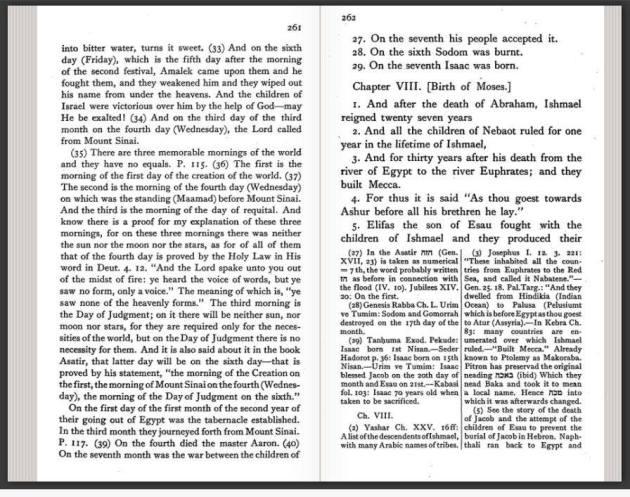
============================================================================
4. Meccah and Medina On The Bible – Genesis 10:30
Today, very few Muslims and Christians
alike are aware of that Mecca – along with Medina – is explicitly
mentioned by name in an early rabbinic translation of the Pentateuch. In
Genesis 10:30 according to the Masoretic Text we read the following:
“And their dwelling was from Mesha, as thou goest toward Sephar, unto the mountain of the east.” [JPS, 1917]
However, the above passage according to
the Judeo-Arabic translation – i.e. process of reading run as in Arabic,
but the script is written with Hebrew letters – made by Rabbi Saadia
ben Joseph al-Fayyumi (ca. 882-942), also known as Saadia Gaon, reads
as:

Translation:
“And their dwelling was from Mecca towards al-Medina, unto the mountain of the East.” [Œuvres complètes de R. Saadia ben Iosef al-Fayyoûmî, ed. by J. Darenbourg, vol. 1 (Paris: E. Leroux, 1893), p. 17.]
Everyone who is familiar with Hebrew will
not contradict me in this matter (Mekka was marked with blue color,
al-Medina with red color). First of all, Saadia Gaon is one of the most
prominent Jewish scholars, and it is said that his translation holds an
unchallengeable authority over all other biblical translations, since he
was the best especially in scriptural exegesis, Jewish history and
Talmudic knowledge in general, and he is responsible for the first and
most important Arabic translation of the Torah which became the standard
version for all Jews living in Muslim countries. Maimonides himself, a
great and respected Rabbi (1135-1204) said:
“were it not for Saadia, the Torah would almost have disappeared from the midst of Israel; for it was he who made manifest what was obscure therein, made strong what had been weakened, and made it known far and wide by word of mouth and in writing.” [H. Malter, Saadia Gaon: His Life and Works, (Philadelphia: The Jewish Publication Society of America, 1921), p. 279.]
Therefore, as you can see, his
translation is a primary source when it comes to the accuracy of Old
Testament interpretation. As to the mentioning of Mecca and Medina in
Genesis, let us recall e.g. the statement of the Rev. Professor William
Paul who in his critical interpretation to the Hebrew fragment הַקֶּדֶם
הַר [#996] from Genesis 10:30, has wrote: “mountain (mountains) of the
East. These are supposed to be those mountains of Arabia running from
the neighbourhood of Mecca and Medina to the Persian Gulf.” [Rev. W.
Paul, Analysis and critical interpretation of the Hebrew text of the Book of Genesis, (Edinburgh: W. Blackwood & Sons, 1852), p. 100.]
Other scholars also shares a similar view.
This of course explain why rabbi Saadia
Gaon has mentioned Mecca and Medina in Genesis 10:30. This is not only
his paraphrase concluded from the context as some might think, because
if you go to the Hebrew text you will notice there such word as באכה
(baka) which was translated as “as thou goest” !
Similarly The Christians Scholars stated :Barnes’ Notes on the Bible while commenting on Genesis 10:30 http://biblehub.com/commentaries/ge…
The situation of Mesha is uncertain. But it is obviously the western boundary of the settlement, and may have been in the neighborhood of Mecca and Medina. Sephar is perhaps the Arabic Zaphari, called by the natives Isfor, a town on the south coast near Mirbat. It seems, however, to be, in the present passage, the “mount of the east” itself, a thuriferous range of hills, adjacent, it may be, to the seaport so-called. Gesenius and others fix upon Mesene, an island at the head of the Persian Gulf, as the Mesha of the text. But this island may have had no existence at the time of the Joctanite settlement. These boundaries include the greater part of the west and south coast of the peninsula, and are therefore sufficient to embrace the provinces of Hejaz (in part), Yemen, and Hadramaut, and afford space for the settlements of the thirteen sons of Joctan. The limits thus marked out determine that all these settlers, Ophir among the rest, were at first to be found in Arabia, how far soever they may have wandered from it afterward.
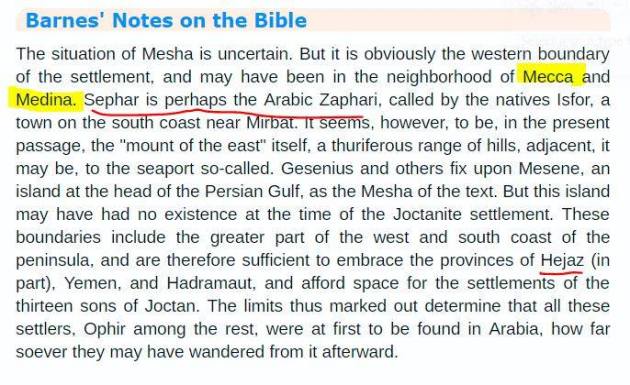
And their dwelling was from Mesha, as thou goest unto Zephar, a mount of the east. Mesha, which is thought to be the Muza of Ptolemy and Pliny, was a famous port in the Red sea, frequented by the merchants of Egypt and Ethiopia, from which the Sappharites lay directly eastward; to whose country they used to go for myrrh and frankincense, and the like, of which Saphar was the metropolis, and which was at the foot of Climax, a range of mountains, which perhaps might be formerly called Saphar, from the city at the bottom of it, the same with Zephar here: by inspecting Ptolemy’s tables (o), the way from one to the other is easily discerned, where you first meet with Muza, a port in the Red sea, then Ocelis, then the mart Arabia, then Cane, and so on to Sapphar or Sapphara; and so Pliny says (p), there is a third port which is called Muza, which the navigation to India does not put into, only the merchants of frankincense and Arabian odours: the towns in the inland are the royal seat Saphar; and another called Sabe; now the sons of Joktan had their habitations all from this part in the west unto Zephar or Saphar eastward, and those were reckoned the genuine Arabs: Hillerus (q) gives a different account of the situation of the children of Joktan, as he thinks, agreeably to these words of Moses; understanding by Kedem, rendered the east, the mountains of Kedem, or the Kedemites, which sprung from Kedem or Kedomah, the youngest son of Ishmael, Genesis 25:15 and Zephar, the seat of the Sepharites, as between Mesha and Kedem; for, says he, Mesha is not Muza, a mart of the Red sea, but Moscha, a famous port of the Indian sea, of which Arrian and Ptolemy make mention; and from hence the dwelling of the Joktanites was extended, in the way you go through the Sepharites to the mountainous places of Kedem or Cadmus: perhaps nearer the truth may be the Arabic paraphrase of Saadiah (r), which is“from Mecca till you come to the city of the eastern mountain, or (as in a manuscript) to the eastern city,”meaning perhaps Medina, situate to the east; so that the sense is, according to this paraphrase, that the sons of Joktan had their dwelling from Mecca to Medina; and so R. Zacuth (s) says, Mesha in the Arabic tongue is called Mecca; and it is a point agreed upon by the Arabs that Mesha was one of the most ancient names of Mecca; they believe that all the mountainous part of the region producing frankincense went in the earliest times by the name of Sephar; from whence Golius concludes this tract to be the Mount Zephar of Moses, a strong presumption of the truth of which is that Dhafar, the same with the modern Arabs as the ancient Saphar, is the name of a town in Shihr, the only province in Arabia bearing frankincense on the coast of the Indian ocean (t).(o) Geograph. l. 6. c. 7. (p) Nat. Hist. l. 6. c. 23. (q) Onomastic. Sacr. p. 116. (r) In Pocock. Specimen Hist. Arab. p. 34. (s) In Juchasin, fol. 135. 2.((t) Universal History, vol. 18. p. 353.
5. Meccah, Pilgrimage in The Bible Exodus 5.1
This verse will puzzled all Christians and Jews, While in Egypt we read that YHWH was instructing Moses to inform Pharoah International Standard Version After Moses and Aaron arrived, they told Pharaoh, “This is what the LORD God of Israel says: ‘Let my people go so they may make a pilgrimage for me in the desert.'”
NET Bible
Afterward Moses and Aaron went to Pharaoh and said, “Thus says the
LORD, the God of Israel, ‘Release my people so that they may hold a pilgrim feast to me in the desert.'”
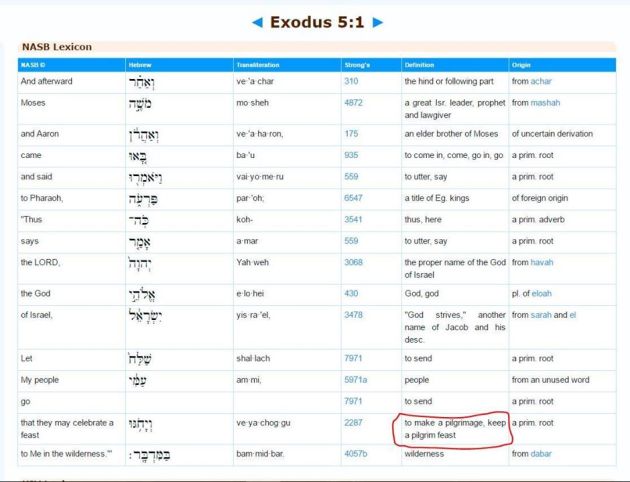
Its really a mind boggling to learn that
Moses and Children of Israel was instructed to make a pilgrimage feast
when the Temple of Solomon was not yet been built. Does the command “make a pilgrimage for me in the desert” therefore
would make a sense if there is no dedicated temple for the intended
purpose? Of course it would make sense only if a Temple exist. But the
problem is, the Temple of Solomon was not yet in existence during this
period. The Temple Of Solomon came only to existence only after 966
years from the time of Exodus. The command “make a pilgrimage for me in the desert” will make sense only if the PILGRIMAGE FEAST is to be performed at Meccah. Some Bible experts confirmed this facts. Cambridge Bible for Schools and Colleges while commenting on Exodus 5:1
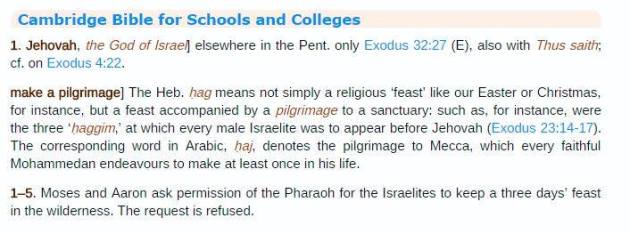
make a pilgrimage] The Heb. ḥag means not simply a religious ‘feast’ like our Easter or Christmas, for instance, but a feast accompanied by a pilgrimage to a sanctuary: such as, for instance, were the three ‘ḥaggim,’ at which every male Israelite was to appear before Jehovah (Exodus 23:14-17). The corresponding word in Arabic, ḥaj, denotes the pilgrimage to Mecca, which every faithful Mohammedan endeavours to make at least once in his life.
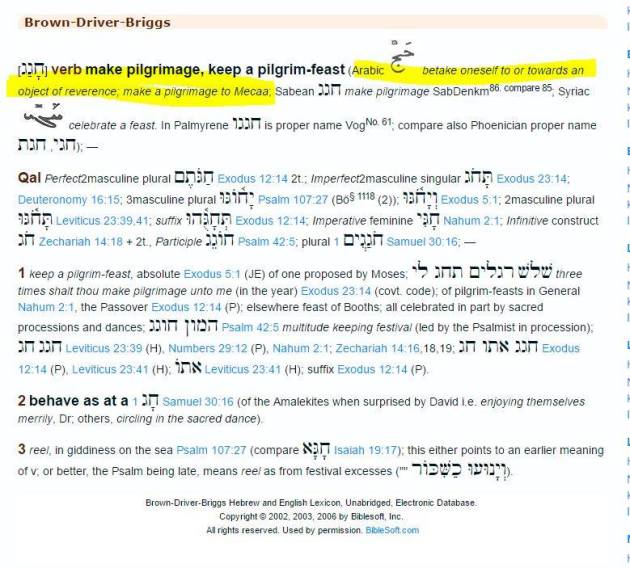
Brown digger as well revealed h**p://biblehub.com/hebrew/2287.htm
Brown-Driver-Briggs[חָגַג] verb make pilgrimage, keep a pilgrim-feast (Arabic http://biblehub.com/bdbgif/bdb02900… betake oneself to or towards an object of reverence; make a pilgrimage to Mecaa; Sabean חגג make pilgrimage SabDenkm86. compare 85; Syriac http://biblehub.com/bdbgif/bdb02900… celebrate a feast. In Palmyrene חגגו is proper name VogNo. 61; compare also Phoenician proper name חגי, חגת); —
Qal Perfect2masculine plural חַגֹּתֶם Exodus 12:14 2t.; Imperfect2masculine singular תָּחֹג Exodus 23:14; Deuteronomy 16:15; 3masculine plural יָח֫וֺגּוּ Psalm 107:27 (Bö§ 1118 (2)); וְיָחֹ֫גּוּ Exodus 5:1; 2masculine plural תָּחֹ֫גּוּ Leviticus 23:39,41; suffix תְּחָגֻּ֫הוּ Exodus 12:14; Imperative feminine חָגִּי Nahum 2:1; Infinitive construct חֹג Zechariah 14:18 + 2t., Participle חוֺגֵג Psalm 42:5; plural חֹגְַגִים 1 Samuel 30:16; —
1 keep a pilgrim-feast, absolute Exodus 5:1 (JE) of one proposed by Moses; שׁלשׁ רגלים תחג לי three times shalt thou make pilgrimage unto me (in the year) Exodus 23:14 (covt. code); of pilgrim-feasts in General
Of course Christians will oppose their
own scholars when their faith is threaten, some of them will simply tell
us that the pilgrimage feast just occured somewhere in Egypt. This can
not be because as mentioned earlier, Pilgrimage -feast require a
dedicated place, area or temple. Another compelling reason that the
pilgrimage must be somewhere out of Egypt was the very purpose of the
Pilgrimage itself, Ellicott’s Commentary for English Readers
wrote: In the wilderness—i.e.,
beyond the frontier, or, at any rate, beyond inhabited Egypt—that the
Egyptians might not be driven to fury by seeing animals sacrificed which
they regarded as sacred. (See Exodus 8:26, and the comment ad loc.)
Pulpit Commentary rationalizing the place of pilgrimage The rationale
of the demand is given in ch. 8:26. The Israelites could not offer
their proper sacrificial animals in the presence of the Egyptians
without the risk of provoking a burst of religious animosity, since
among the animals would necessarily be some which all, or many, of the
Egyptians regarded as sacred, and under no circumstances to be killed.
The fanaticism of the Egyptians on such occasions led to wars, tumults,
and massacres. (See Plutarch, ‘De Isid. et Osir.,’ § 44.) To avoid this
danger the “feast” must be held beyond the bounds of Egypt – in the
adjacent “wilderness.”
============================================================================
6. Mecca did exist before the advent of Christianity -Secular historical evidence
Makkah, or Mecca, is the centre of Islamic civilization. Qur’an terms it as Ummul Qura’
i.e. Mother of the Cities (6: 92 & 42: 7). It is the place to which
all Muslims turn their faces five times a day and making a pilgrimage
to it once in life is not only an obligation but the heartiest desire of
every Muslim.Apparently it is only the importance of this city which
gives us ‘mecca’ as a word in the English language meaning, ‘a place frequented for special purpose.’
But this is not all; its central position
in the House of Islam has lead some jaundiced-eye critics of Islam to
even doubt its historicity. They say that history of Arabia has no
evidence for the existence of Makkah before the advent of Christianity.
Infact there are references to the city
and sanctuary of Makkah even in the Old Testament. But in the following
lines I will not bask upon references from the Bible but instead share a
secular historical evidence to refute the lie.
Diodorus Siculus, a first century B.C. Greek historian while discussing Arabia writes;
“The people that inhabit these parts are called Bizomenians and live upon wild beasts taken in hunting. Here is a sacred temple in high veneration among all the Arabians.”
(The Historical Library of the Diodorus the Sicilian, Translated by G.
Booth, Esq., J. Davis Military Chronicle Office, London 1814 vol.1
p.184)
This certainly is a reference to Makkah. Georgi Zaidan (d. 1914 C.E.), a Christian Arab from Beirut writes in his book Al-‘Arab Qabl al-Islam (Arabs before Islam);

“There is no mention
of Makkah or Ka’ba in the books of the Greeks of antiquity except what
is found in the book of Diodorus Siculus of the first century before
Christ in his discussion about the Nabateans. In that he refers to
Makkah and he writes, ‘And beyond the land of the Nabateans is the
region of Bizomenians. And there is a sacred temple in high veneration
among all the Arabs.’”
And he does not just stop here, he even
explains as to whom Diodorus refers to by using the word, “Bizomenians.”
He writes (Arabic wording is given in the image above);
“As to the
‘Bizomenians’; sometimes by it are intended the Jurhamites or other
Arabian tribes who were the custodians of Makkah.” (Al-‘Arab Qabl al-Islam, Al-Hilal publishers Cairo, second ed. vol.1 p.244)
So we find a Christian testifying for and expounding a historical evidence for Makkah from pre-Christian times.
Similarly another Arab Christian, Jesuit Louis Cheikho (d. 1927 C.E.) in his work titled, ‘al-Nasaraniyah wa adaabuha bayn ‘Arab al-Jahaliyyah’
(The Christianity and Its Literature amongst the Arabs of Pre-Islamic
Times) also refers to the same quotation from Diodorus Siculus and takes
it like Zaidan. (See al-Nasaraniyah wa adaabuha bayn ‘Arab
al-Jahaliyya, Darul Mashriq, Beirut second ed. 1989 p.14)
I hope objective readers will find this piece useful.
================================================================
7. Return to Meccah Book By Judeo Christian Rabbi Avi Lipkin
Another modern Judeo Christians Scholars has clearly mentioned in
his Book Return to Meccah, that Moses had been to PILGRIMAGE with
Kahba..
=======================================================================
Related articles :
Additional reading materials and refutation : https://www.bismikaallahuma.org/his…
Additional reading materials and refutation : https://www.bismikaallahuma.org/his…
Recent scholarship shows that Mecca enjoyed some significance in the minds of pre-Islamic Christians.





Very informative contact i really like. If you are interested to visit best places visit my website Famous Places in Karachi
ReplyDelete